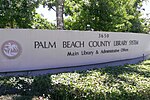Lake Clarke Shores, Florida

Lake Clarke Shores is a town in Palm Beach County, Florida, United States. Located in the east-central portion of the county, the town is situated just west of the south end of West Palm Beach, north and west of the north end of Lake Worth Beach, and east of Palm Springs. The 2020 census recorded a population of 3,564. The town was named after John Newton Clarke, who first filed a homestead claim in the area in 1897. Clarke intended to capitalize on the business of growing pineapples, but his efforts were ultimately unsuccessful. Very few people lived in the area until local attorney Walter Travers created a plan to develop a community around Lake Clarke and purchased 250 acres (100 ha) of land for $10,000 in the late 1940s. The completion of a bridge across the West Palm Beach Canal in 1953 spurred a further growth in population. With rumors spreading that West Palm Beach intended to annex the community, residents voted by a wide margin to support the incorporation of Lake Clarke Shores as a town on April 10, 1956, which the Florida Legislature officially approved in 1957. Today, Lake Clarke Shores maintains a small population. The town is primarily a bedroom community, with most of its businesses and other commercial buildings located along Forest Hill Boulevard (State Road 882).
Excerpt from the Wikipedia article Lake Clarke Shores, Florida (License: CC BY-SA 3.0, Authors, Images).Lake Clarke Shores, Florida
West Lake Drive,
Geographical coordinates (GPS) Address Nearby Places Show on map
Geographical coordinates (GPS)
| Latitude | Longitude |
|---|---|
| N 26.645555555556 ° | E -80.075277777778 ° |
Address
West Lake Drive 7564
33406
Florida, United States
Open on Google Maps








